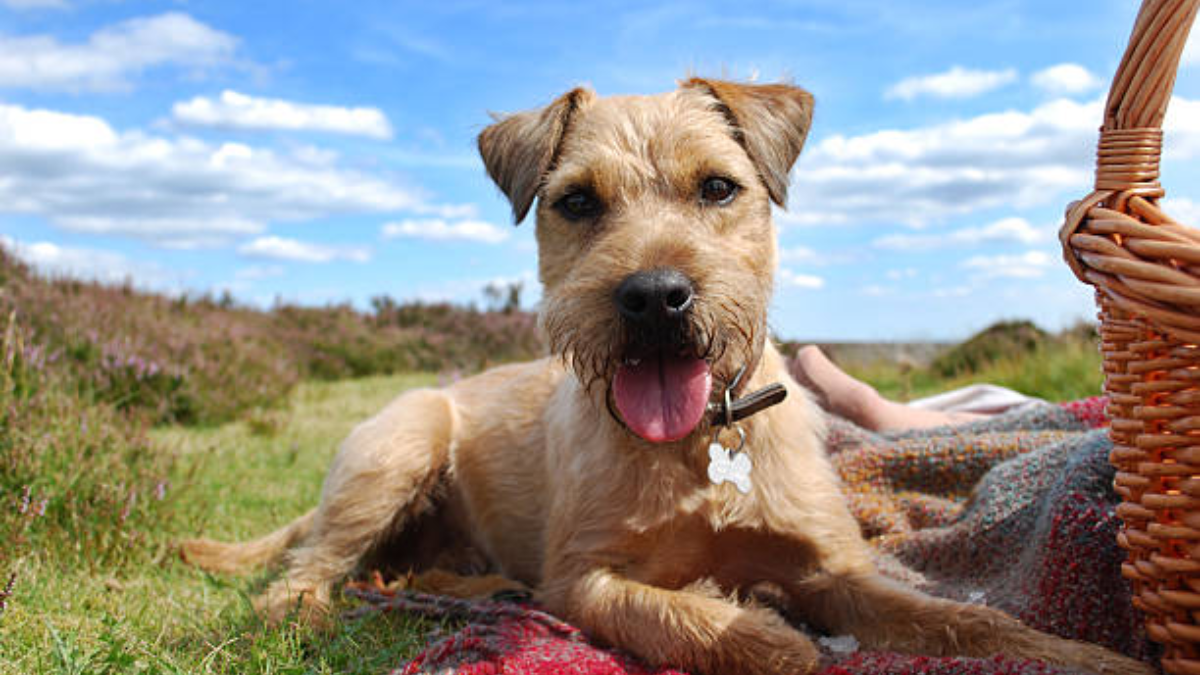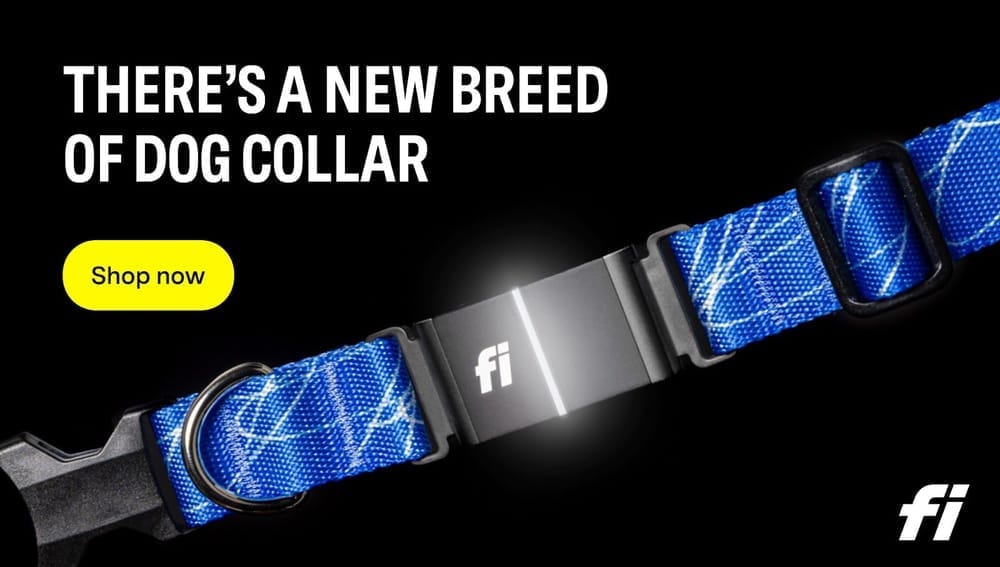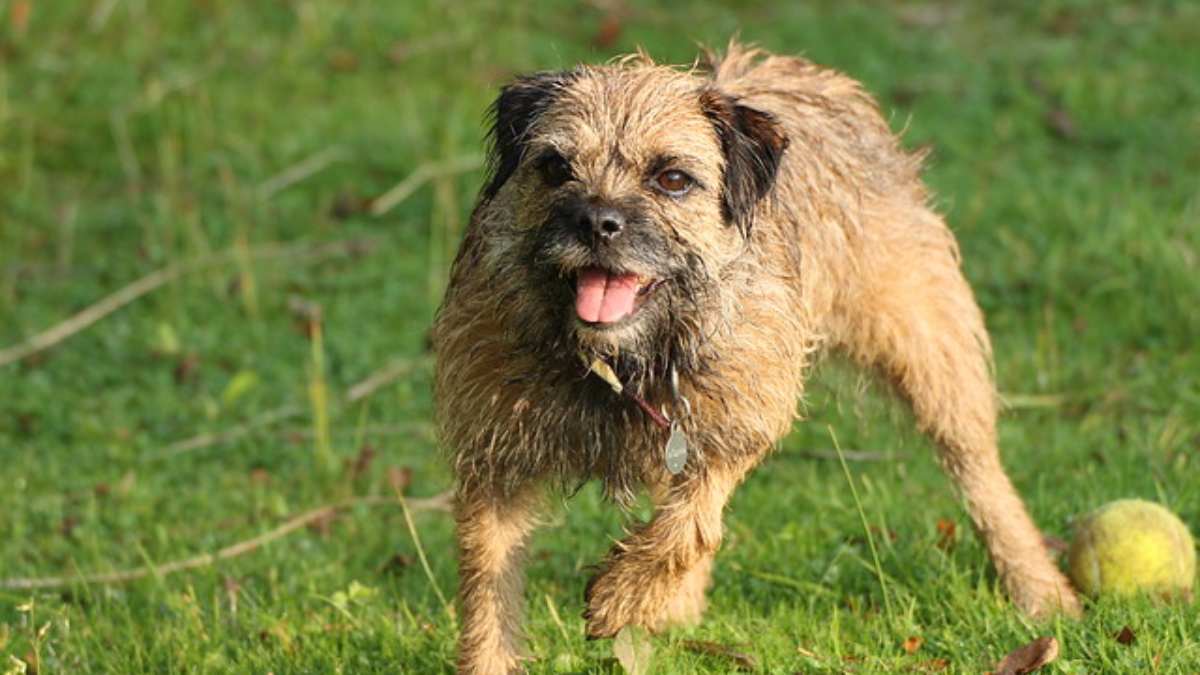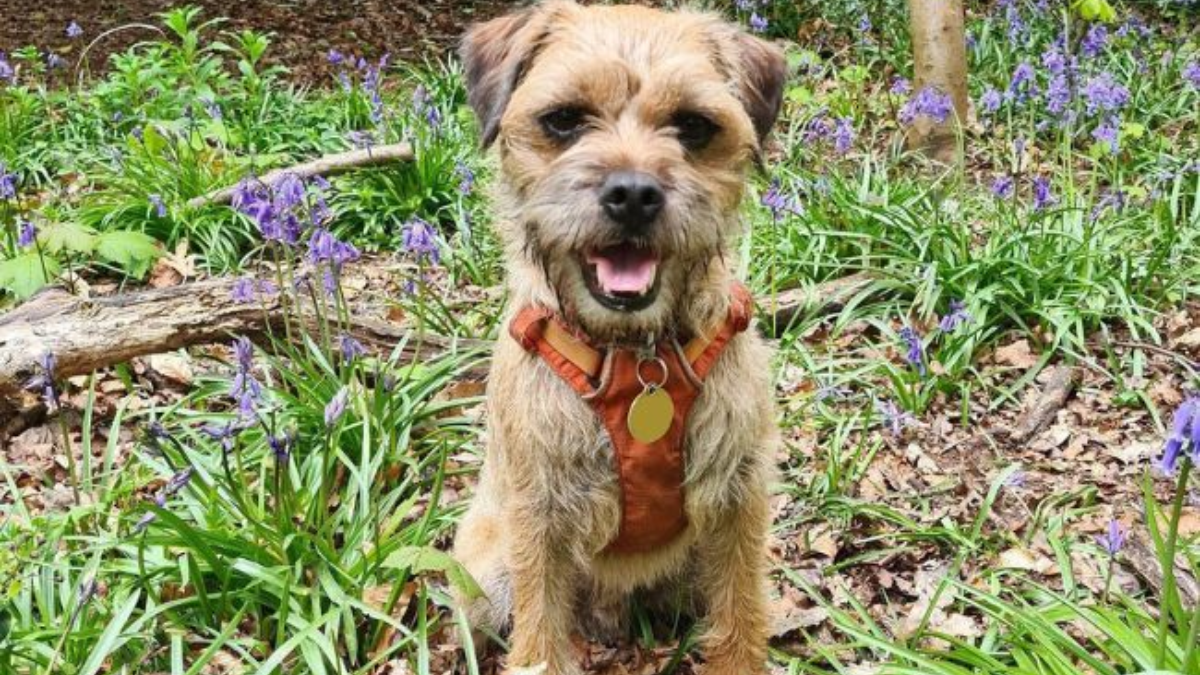Border Terriers are known for their distinct double coats, consisting of a wiry outer coat and a soft undercoat. Stripping is a process that involves removing the dead hair from the dog's coat, which helps to maintain its texture and color. Stripping is a common grooming practice for Border Terriers, but there is often confusion about what age should a Border Terrier be stripped and when it should be done.

The ideal age for a Border Terrier to be stripped is between six and eight months old. At this age, the dog's coat has fully developed, and the dead hair is ready to be removed. Stripping at this age ensures that the coat remains healthy and maintains its texture and color. However, it is important to note that the timing of stripping can vary depending on the individual dog's coat and lifestyle.
Understanding the Border Terrier Coat
Border Terriers are known for their wiry and dense double coat, which protects them from harsh weather conditions and rough terrain. Understanding the characteristics of their coat is essential for maintaining their health and appearance.
Double Coat Characteristics
The Border Terrier's coat consists of two layers: the harsh, wiry topcoat and the soft, dense undercoat. The topcoat is designed to repel water and dirt, while the undercoat provides insulation and warmth. The texture of the coat is rough and wiry to the touch, and it is resistant to matting and tangling.
The natural oils in the coat help to maintain its texture and provide a natural shine. However, if the coat is not stripped regularly, dead hair can accumulate and prevent the natural oils from reaching the skin, resulting in a dull and unhealthy appearance.
Importance of Coat Stripping
Coat stripping is the process of removing dead hair from the coat to maintain its texture and appearance. It involves pulling out the dead hair by hand or using a stripping knife, which promotes the growth of new, healthy hair.
Regular coat stripping is essential for maintaining the Border Terrier's natural look and preventing matting and tangling. It also helps to distribute natural oils throughout the coat, which promotes healthy skin and prevents skin irritation and infection.

The frequency of coat stripping depends on the individual dog's coat and lifestyle. Generally, Border Terriers should be stripped two to four times a year, with additional touch-ups as needed. It is important to consult with a professional groomer or breeder for guidance on the appropriate frequency and technique for stripping your Border Terrier's coat.
Overall, maintaining a healthy and well-groomed coat is crucial for the health and appearance of your Border Terrier. With proper care and attention, their coat will continue to protect and enhance their natural beauty.
When to Begin Stripping
Stripping is an important grooming task for Border Terriers, and it involves removing the dead hair from the dog's coat. It is essential to start stripping at the right age to ensure that the dog's coat remains healthy and looks its best. In this section, we will discuss the right age to begin stripping and the factors that influence the frequency of stripping.
Identifying the Right Age
The ideal age to start stripping a Border Terrier is when the puppy is around six to eight months old. At this stage, the puppy's coat starts to become harsher, and the undercoat begins to develop. Stripping at this age helps to remove the dead hair and encourages the growth of a healthy, wiry coat. If you wait too long to start stripping, the coat may become too soft, and it will be more challenging to maintain the proper texture.
Factors Influencing Stripping Frequency
The frequency of stripping depends on several factors, including the dog's activity level, health, and shedding rate. Border Terriers that are more active and spend more time outdoors may need to be stripped more frequently than those that are less active. Dogs that are shedding excessively may also need to be stripped more often to remove the dead hair and prevent matting.

It is essential to follow some general guidelines when deciding how often to strip your Border Terrier. Typically, you should strip your dog every four to six months, but this can vary depending on the factors mentioned above. If you are unsure about how often to strip your dog, consult with a professional groomer or your veterinarian.
In conclusion, starting to strip your Border Terrier at the right age is crucial to maintaining a healthy and beautiful coat. Following the guidelines for stripping frequency and considering the factors that influence it will help ensure that your dog's coat remains in optimal condition.
Stripping vs Clipping
Border Terriers have a thick double coat that requires regular grooming to maintain its texture and healthy appearance. Stripping and clipping are two techniques used to groom the Border Terrier's coat.
Comparing Techniques
Stripping is the process of removing dead hair from the coat by pulling it out with a stripping knife or fingers. This technique helps to maintain the texture of the coat and gives it a natural look. Hand stripping is the preferred method as it removes dead hair from the root and promotes the growth of new hair. Stripping is also believed to offer protection to the coat against the elements.
On the other hand, clipping involves using electric clippers to cut the hair to a uniform length. Clipping is a quicker method of grooming and is often used for show dogs. However, it can damage the texture of the coat and cause it to lose its natural look. Clipping is also not as effective in removing dead hair from the root, which can lead to a less healthy coat.
Effects on Coat Health
Hand stripping helps to maintain a healthy coat by promoting the growth of new hair and removing dead hair from the root. This technique also helps to distribute natural oils throughout the coat, which keeps it moisturized and healthy. The texture of the coat is also maintained, which provides better protection against the elements.

Clipping, on the other hand, can cause the coat to lose its texture and become less healthy. Clipping can also lead to uneven growth and cause the coat to become matted more easily. This can lead to skin irritation and other health issues.
In conclusion, stripping is the preferred method of grooming for Border Terriers as it helps to maintain the texture and healthy appearance of the coat. Hand stripping is the most effective method as it removes dead hair from the root and promotes the growth of new hair. Clipping should only be used for show dogs or in cases where the coat is severely matted.
Stripping Techniques and Tools
Basic Hand Stripping Method
Hand stripping is a grooming technique that involves removing dead hairs from the dog's coat. This process helps to maintain the texture and color of the coat and also encourages the growth of new hairs. The basic hand-stripping method involves plucking out individual hairs by hand, using a technique that requires skill and practice.
The first step in hand stripping is to identify the direction of hair growth. This is important because it determines the direction in which the hairs should be plucked. The groomer should use a stripping knife or comb to help grip the hairs and pull them out in the correct direction.
The groomer should grip the hair between their thumb and forefinger and pull it out in a smooth, quick motion. The hair should be pulled out at the root, leaving the follicle intact. This process should be repeated all over the dog's body, focusing on areas where dead hairs are most prevalent.
Tools of the Trade
Hand stripping requires a few specific tools to be effective. The most important tool is a stripping knife, which is used to grip and pull out individual hairs. The knife should be sharp and well-maintained, as a dull knife can damage the dog's skin.

In addition to a stripping knife, a comb and scissors may also be used to help with the grooming process. The comb can be used to help grip individual hairs and pull them out in the correct direction. Scissors may be used to trim excess hair or to shape the dog's coat.
Overall, hand stripping is a skill that requires practice and patience. With the right tools and technique, a groomer can effectively remove dead hairs from a Border Terrier's coat and maintain its texture and color.
Maintaining the Stripped Coat
Border Terriers have a unique coat that requires regular maintenance to keep it looking healthy and beautiful. Stripping is an essential part of grooming a Border Terrier, and it is important to maintain the stripped coat to keep it in top condition. In this section, we will discuss the routine grooming steps and how to manage the coat between stripping sessions.
Routine Grooming Steps
Regular grooming is essential to keep the Border Terrier's coat healthy and looking its best. The following steps should be included in a regular grooming routine:
- Brushing: Brushing the coat regularly helps to remove any dead hair and dirt, and it also helps to distribute natural oils throughout the coat. Use a slicker brush or a pin brush to brush the coat thoroughly.
- Bathing: Bathing should be done only when necessary, as frequent bathing can strip the coat of its natural oils. Use a mild shampoo and conditioner specifically designed for dogs to keep the coat clean and healthy.
- Stripping: Stripping should be done every 6-8 weeks to remove dead hair and promote healthy hair growth. Use thinning shears or a stripping knife to remove the dead hair.
- Rolling: Rolling the coat helps to remove any dead hair and keep the coat looking neat. Use a stripping comb or a carding tool to roll the coat.

Managing Coat Between Stripping Sessions
In between stripping sessions, it is important to manage the coat to keep it in top condition. The following steps should be included in a regular coat management routine:
- Brushing: Brush the coat regularly to remove any dead hair and dirt. Use a slicker brush or a pin brush to brush the coat thoroughly.
- Rolling: Rolling the coat helps to remove any dead hair and keep the coat looking neat. Use a stripping comb or a carding tool to roll the coat.
- Thinning Shears: Use thinning shears to remove any excess hair and keep the coat looking neat.
- Conditioner: Use a conditioner specifically designed for dogs to keep the coat healthy and shiny.
- Healthy Hair Growth: To promote healthy hair growth, make sure your Border Terrier is getting a balanced diet with plenty of protein and vitamins.
By following these routine grooming steps and managing the coat between stripping sessions, you can keep your Border Terrier's stripped coat looking healthy and beautiful.
Professional Stripping vs Home Grooming
When it comes to stripping a Border Terrier's coat, pet owners have two options: professional grooming or home grooming. Each option has its advantages and disadvantages, and it is up to the individual owner to decide which is best for their dog.
Deciding on Professional Grooming
Professional grooming is a great option for pet owners who don't have the time, skill, or tools to strip their Border Terrier's coat themselves. Professional groomers have the training and experience to properly strip a Border Terrier's coat according to the AKC breed standard and conformation. They also have access to professional-grade tools, which can make the process faster and more efficient.
However, professional grooming can be expensive, and some pet owners may not be comfortable leaving their dogs with a stranger. It is important to do research and find a reputable groomer who has experience working with Border Terriers.
Tips for Home Stripping
Home grooming can be a more cost-effective option for pet owners who have the time and skill to strip their Border Terrier's coat themselves. It can also be a bonding experience between the owner and their dog.
Before attempting to strip their Border Terrier's coat at home, pet owners should invest in the proper tools, such as a stripping knife and comb. They should also research the proper techniques and watch instructional videos to ensure they are doing it correctly.
It is important to note that stripping a Border Terrier's coat is a skill that takes practice to master. Pet owners should start slowly and work on small sections at a time. They should also be aware of their dog's individual needs and adjust their technique accordingly.
In conclusion, both professional stripping and home grooming are valid options for pet owners looking to maintain their Border Terrier's coat. It is important to weigh the advantages and disadvantages of each option and choose the one that is best for the individual dog and owner.
Health and Comfort Considerations
Preventing Discomfort and Injuries
Stripping a Border Terrier's coat is a necessary grooming procedure that involves removing dead hair from the root. It is essential to maintain a healthy coat and prevent discomfort and injuries. Stripping helps to maintain the coat's texture and grip, which is essential for the breed's working ability. It also helps to prevent matting, which can cause skin irritations and infections.
If a Border Terrier's coat is not stripped regularly, it can become matted, making it difficult to groom. This can cause discomfort and pain for the dog, which can lead to injuries. Stripping is a gentle process that does not involve pulling the hair out. It is essential to use the correct technique and tools to avoid injuring the dog.
Addressing Skin and Coat Issues
Border Terriers are prone to skin and coat issues, such as allergies and matted fur. Stripping can help to prevent these issues by removing dead hair from the root, which allows new hair to grow. It also helps to distribute natural oils throughout the coat, which improves the coat's health and shine.

Regular stripping can also help to prevent nail issues by keeping the dog's nails short. Long nails can cause discomfort and pain for the dog, making it difficult for them to walk. Stripping can also help to prevent ear infections by removing excess hair from the ear canal, allowing air to circulate and reducing the risk of infections.
It is essential to use the right shampoo and treats when grooming a Border Terrier. Using the wrong shampoo or treats can cause skin irritations and allergies. It is also important to touch the dog gently and avoid pulling or tugging on the hair, which can cause discomfort and pain.
In conclusion, stripping a Border Terrier's coat is an essential grooming procedure that helps to maintain the dog's health and comfort. It is important to use the correct technique and tools to avoid injuring the dog. Regular stripping can help to prevent skin and coat issues, nail issues, and ear infections. Using the right shampoo and treats and handling the dog gently are also critical factors to consider when grooming a Border Terrier.
Detailed Stripping Process
Step-by-Step Stripping Guide
Hand-stripping a Border Terrier's coat is a skill that requires practice and patience. The stripping process involves removing the dead hair from the dog's coat using a stripping knife. Here is a step-by-step guide to help you strip your Border Terrier's coat:
- Start by brushing the dog's coat to remove any tangles or mats. This will make the stripping process easier and more comfortable for the dog.
- Use a stripping knife to remove the dead hair from the dog's coat. Hold the knife at a 45-degree angle and work in the direction of the hair growth.
- Work on one section of the dog's coat at a time, starting from the neck and working your way down to the tail.
- Use your fingers to feel for any thinned areas of the coat and focus on those areas first.
- Once you have stripped a section of the coat, use a brush to remove any loose hair.
Stripping Specific Body Parts
When stripping a Border Terrier's coat, there are specific body parts that require special attention. Here are some tips for stripping specific body parts:
Legs
When stripping the legs, start at the top of the leg and work your way down to the paw. Be careful not to strip too much hair from the paw pads as this can cause discomfort for the dog.

Tail
When stripping the tail, start at the base and work your way towards the tip. Be careful not to strip too much hair from the tail as this can cause it to look too thin.
Neck
When stripping the neck, start at the base of the neck and work your way towards the head. Be careful not to strip too much hair from the neck as this can cause discomfort for the dog.
Cheeks
When stripping the cheeks, start at the top of the cheek and work your way towards the jaw. Be careful not to strip too much hair from the cheeks as this can cause discomfort for the dog.
Sanitary
When stripping the sanitary area, be gentle and use a light touch. This area is sensitive, and the dog may become uncomfortable if you apply too much pressure.
Overall, hand-stripping a Border Terrier's coat is a skill that requires practice and patience. By following these tips and techniques, you can help keep your dog's coat looking healthy and beautiful.
Aftercare and Maintenance
Post-Stripping Care
After a Border Terrier has been stripped, it is important to take proper care of their coat to maintain its health and appearance. This involves regular bathing and conditioning, as well as ensuring that the dog's natural oils are replenished.
Bathing should be done regularly, but not too frequently as this can strip the coat of its natural oils. A good rule of thumb is to bathe a Border Terrier every 2-3 months, or as needed if they get particularly dirty. When bathing, it is important to use a mild shampoo designed for dogs, as human shampoos can be too harsh and strip the coat of its natural oils.
Conditioning is also important to keep the coat healthy and shiny. A good conditioner will help to detangle the hair and keep it soft and manageable. It is recommended to use a conditioner after every bath, or as needed if the coat becomes dry or brittle.

In addition to regular bathing and conditioning, it is important to ensure that the dog's natural oils are replenished. This can be done by feeding the dog a healthy diet rich in omega-3 fatty acids, which are essential for maintaining healthy skin and coat. Alternatively, supplements can be added to the dog's diet to ensure they are getting the necessary nutrients.
Overall, proper aftercare and maintenance are crucial for keeping a Border Terrier's coat healthy and looking its best. By following these simple steps and taking care to replenish the dog's natural oils, owners can ensure that their dog's coat remains shiny, soft, and healthy.
Conclusion:
In conclusion, determining What Age Should a Border Terrier Be Stripped? is essential for maintaining their coat's health and appearance. While Border Terriers are known for their distinct double coats, consisting of a wiry outer coat and a soft undercoat, stripping is a common grooming practice to remove dead hair and maintain texture and color.
However, there is often confusion about the appropriate age for this grooming procedure. Some experts recommend starting the stripping process as early as 6 months old, while others suggest waiting until the dog's coat fully develops, typically around 9 to 12 months old.
Regardless of the exact age, it's important to consider the individual dog's coat development and consult with a professional groomer or veterinarian for personalized advice. Stripping too early or too late can potentially affect the coat's texture and appearance.
Ultimately, regular grooming and maintenance are key to keeping a Border Terrier's coat healthy and looking its best. By understanding the appropriate age for stripping and following proper grooming techniques, owners can ensure their Border Terrier maintains a vibrant and well-maintained coat throughout their life.
Frequently Asked Questions
- At what stage in development should hand stripping begin for a Border Terrier?
- Hand stripping is a grooming technique that involves pulling out dead hairs from the coat of a Border Terrier. This process should begin when the dog is around 6 months old, and the coat has started to develop. It is important to start the process early to ensure that the dog gets used to it and is comfortable with the procedure.
- What are the signs that my Border Terrier is ready to be stripped?
- The best indicator that a Border Terrier is ready to be stripped is when the coat starts to look dull and shaggy. This is usually around 6 to 8 months of age. Other signs that the dog is ready include the coat being thick and wiry and the presence of dead hair that can be easily pulled out.
- How frequently should the stripping process be done for a Border Terrier?
- The frequency of stripping depends on the individual dog and the quality of the coat. Generally, Border Terriers should be stripped every 3 to 4 months to maintain the coat's texture and appearance. However, some dogs may require more frequent stripping, while others may need it less often.
- Can you recommend the ideal tools for hand stripping my Border Terrier?
- The ideal tools for hand stripping a Border Terrier include a stripping knife, a stripping stone, and a grooming table. The stripping knife is used to pull out dead hairs, while the stripping stone is used to sharpen the knife. The grooming table makes the process easier by providing a stable platform for the dog.
- Is there a specific season or time of year that is best for stripping a Border Terrier?
- There is no specific season or time of year that is best for stripping a Border Terrier. However, it is important to avoid stripping the dog during the winter months when the coat is at its thickest. Stripping during this time can cause the dog to become too cold.
- What are the behavioral indicators that a Border Terrier has reached maturity for stripping?
- Behavioral indicators that a Border Terrier has reached maturity for stripping include the dog being calm and relaxed during the grooming process. The dog should not be anxious or nervous and should allow the owner to handle them without any issues. Additionally, the coat should be fully developed and have a wiry texture.




